Northrop T-38 Talon
The Northrop T-38 Talon is a two-seat, twinjet supersonic jet trainer. It was the world's first supersonic trainer and is also the most produced. The T-38 remains in service as of 2020 in several air forces.
| T-38 Talon | |
|---|---|
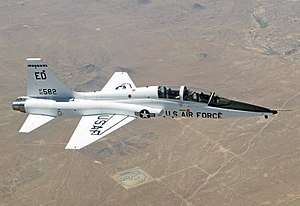 | |
| A T-38A from Edwards Air Force Base | |
| Role | Advanced trainer |
| National origin | United States |
| Manufacturer | Northrop Corporation |
| First flight | 10 April 1959 |
| Introduction | 17 March 1961 |
| Status | Operational |
| Primary users | United States Air Force United States Navy NASA Turkish Air Force |
| Produced | 1961–1972 |
| Number built | 1,146 |
| Unit cost |
US$756,000 (1961 constant dollars) US$6.173 million (2016 dollars) |
| Developed from | Northrop N-156 |
| Variants | Northrop F-5 |
The United States Air Force (USAF) operates the most T-38s. In addition to training USAF pilots, the T-38 is used by NASA. The U.S. Naval Test Pilot School is the principal US Navy operator (other T-38s were previously used as USN for Dissimilar air combat training until replaced by the similar Northrop F-5 Tiger II). Pilots of other NATO nations fly the T-38 in joint training programs with USAF pilots.
As of 2019, the T-38 has been in service for over 50 years with its original operator, the United States Air Force.
In September of 2018, USAF announced the replacement of the Talon by the Boeing T-7 Red Hawk with phaseout to begin in 2023.
Design and development

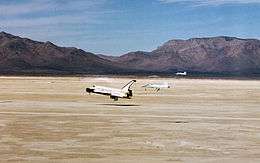


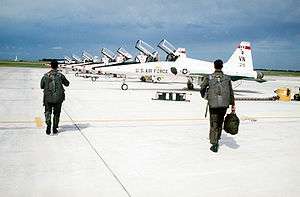
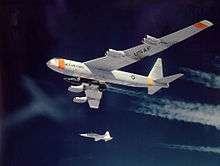

In 1952 Northrop began work on a fighter project, the N-102 Fang, with shoulder-mounted delta wing and a single engine.[1] The proposed General Electric J79 engine, weighing nearly two tons, meant the resulting aircraft would be large and expensive.[2] Then in 1953, representatives from General Electric Aviation's newly created Small Aircraft Engine Department showed Northrop a relatively tiny engine (around 400 lb installed weight) capable of 2,500 lb of thrust, and Northrop VP-Engineering Edgar Schmued saw the possibility of reversing the trend toward the large fighters. Schmued and chief engineer Welko Gasich decided on a small twin-engine "hot-rod" fighter, the N-156. Northrop began its N-156 project in 1954, aiming for a small supersonic fighter jet capable of operating from the US Navy's escort carriers. However, when the Navy chose not to pursue equipping its fleets in that fashion, Northrop continued the N-156 design using in-house funding, recasting it as a lightweight fighter (dubbed N-156F) and aimed at the export market.
In the mid-1950s the USAF issued a General Operating Requirement for a supersonic trainer, planning to retire its 1940s-era Lockheed T-33s. Northrop officials decided to adapt the N-156 to this competition. The only other candidate was the two-seat version of the North American F-100 Super Sabre. Although the F-100 was not considered the ideal candidate for a training aircraft (it is not capable of recovering from a spin),[3] NAA was still considered the favorite in the competition due to that company's favored-contractor status with the Air Force. However, Northrop officials convincingly presented life-cycle cost comparisons which could not be ignored, and they were awarded the contract, receiving an order for three prototypes. The first (designated YT-38) flew on 10 April 1959.[4] The type was quickly adopted and the first production examples were delivered in 1961, officially entering service on 17 March that year, complementing the T-37 primary jet trainer. When production ended in 1972, 1,187 T-38s had been built (plus two N-156T prototypes). Since its introduction, it is estimated that some 50,000 military pilots have trained on this aircraft. The USAF remains one of the few armed flying forces using dedicated supersonic final trainers, as most, such as the US Navy, use high subsonic trainers.[5]
The T-38 is of conventional configuration, with a small, low, long-chord wing, a single vertical stabilizer, and tricycle undercarriage. The aircraft seats a student pilot and instructor in tandem, and has intakes for its two turbojet engines at the wing roots. Its nimble performance has earned it the nickname white rocket. In 1962 the T-38 set absolute time-to-climb records for 3,000, 6,000, 9,000 and 12,000 meters, beating the records for those altitudes set by the F-104 in December 1958. (The F-4 Phantom beat the T-38's records less than a month later.)
The F-5B and F (which also derive from the N-156) can be distinguished from the T-38 by the wings; the wing of the T-38 meets the fuselage straight and ends square, while the F-5 has leading edge extensions near the wing roots and wingtip launch rails for air-to-air missiles. The wings of both the T-38 and the F-5 family use conventional skin over spar-rib structure.[6]
Most T-38s built were of the T-38A variant, but the USAF also had a small number of aircraft converted for weapons training (designated AT-38B), which were fitted with a gunsight and could carry a gunpod, rockets, or bombs on a centerline pylon. As of September 30, 2017, 503 T-38s were still operational with the USAF,[7] with many more in operation around the world. Most of the USAF variant aircraft (T-38A and AT-38B) have been converted to the T-38C through an avionics upgrade program. Improvements include the addition of a HUD, GPS, INS (Inertial Navigation System), and TCAS. Most jets have also received PMP (a propulsion modification to improve low-altitude engine thrust). Approximately a third of the fleet (those that experience more severe usage) are currently undergoing structural replacements and upgrades, as well as receiving new wings, to extend their service life to 2029.
The fighter version of the N-156 was eventually selected for the US Military Assistance Program and produced as the F-5 Freedom Fighter. Many of these have since reverted to a weapons training role as various air forces have introduced newer types into service. The F-5G was an advanced single-engined variant later renamed the F-20 Tigershark. In 2018, the Iranian Air Force announced that an outwardly-similar aircraft, named the Kowsar, had been constructed within Iran.[8][9][10]
Operational history
Military
The USAF Strategic Air Command (SAC) had T-38s in service from 1978 until SAC's 1991 inactivation. These aircraft were used to enhance the career development of bomber and tanker copilots through the "Accelerated Copilot Enrichment Program." They were later used as proficiency aircraft for all B-52, B-1, Lockheed SR-71, U-2, Boeing KC-135, and KC-10 pilots. SAC's successors, the Air Combat Command (ACC) and the Air Force Global Strike Command (AFGSC), continue to retain T-38s as proficiency aircraft for U-2 pilots and B-2 pilots, respectively.[5]
The Air Training Command's (ATC) successor, the Air Education and Training Command (AETC), uses the T-38C to prepare pilots for the F-15C Eagle and F-15E Strike Eagle, the F-16 Fighting Falcon, B-52 Stratofortress, B-1B Lancer, B-2 Spirit, A-10 Thunderbolt, F-22 Raptor and F-35 Lightning II. The AETC received T-38Cs in 2001 as part of the Avionics Upgrade Program. The T-38Cs owned by the AETC have undergone propulsion modernization which replaces major engine components to enhance reliability and maintainability, and an engine inlet/injector modification to increase available takeoff thrust.[5] These upgrades and modifications, with the Pacer Classic program, should extend the service life of T-38s past 2020. The T-38 has an availability goal of 75% which it maintained in 2011, however in 2015 availability is 60%.[11]
Besides the USAF, USN and NASA, other T-38 operators included the German Air Force (Luftwaffe), the Portuguese Air Force, the Republic of China Air Force, and the Turkish Air Force.[5]
Replacement
The USAF launched the T-X Program in 2010 to replace the T-38.[12] Bidders included: a joint venture of BAE Systems and Rolls Royce, offering the Hawk trainer, equipped with Rolls' Adour Mk951 engine with FADEC; Lockheed Martin and Korea Aerospace Industries, offering the T-50; and Raytheon and Alenia Aermacchi offering the T-100, an aircraft whose design originated with the M-346.[13] Boeing and Saab offered a new-technology design powered by the General Electric F404 turbofan engine. The Boeing/Saab bid first flew on December 20, 2016 and on September 27, 2018 was declared the winner of the T-X competition.[14]
NASA
NASA operates a fleet of thirty-two T-38 aircraft[15] and uses the aircraft as a jet trainer for its astronauts, as well as a chase plane. Its fleet is housed primarily at Ellington Field in Houston, Texas. NASA's internal projections show the number of operational jet trainers falling to 16 by 2015. The agency spends $25–30 million annually to fly and maintain the T-38s.[16]
During the Space Shuttle era it was established NASA tradition for astronauts to arrive at the Kennedy Space Center in T-38 Talons.[17]
Civil
There are seven privately owned T-38s in the U.S.[15] Boeing owns two T-38s, which are used as chase planes.[15] Thornton Corporation owns two T-38s and three F-5s and the National Test Pilot School owns one T-38.[15] In addition, two others are in private ownership.[15]
Accidents and incidents
More than 210 aircraft losses and ejections have been documented over the lifetime of the T-38.[18]
- 1964 Oct 31: Astronaut Theodore Freeman was killed as a result of a bird strike on a NASA operated T-38.[19][20]
- 1966 February 28 (1966 NASA T-38 crash): Astronauts Elliot See and Charles Bassett were killed when they struck a building in fog.[21][22]
- 1967 October 5: Astronaut Clifton "C.C." Williams was killed in a crash of a NASA operated T-38 due to an aileron jam.[23][24]
In response to the 1973 OPEC oil embargo, from 1974 to 1983, the U.S. Air Force Thunderbirds aerobatic display team adopted the T-38 Talon, which used far less fuel than the F-4 Phantom. The Blue Angels downsized to the Douglas A-4 Skyhawk at roughly the same time. After the 1982 "Diamond Crash" incident that killed four of the Thunderbirds' six demonstration pilots, the T-38 was replaced in this role by the front line F-16A Fighting Falcon.
Variants

- N-156T: Northrop company designation.
- YT-38: Prototypes, two built with YJ85-GE-1 engines, later designated YT-38A and four pre-production aircraft with YJ-85-GE-5 engines, later designated T-38A.[25]
- T-38A: Two-seat advanced training aircraft, production model, 1,139 built.[25]
- T-38A(N): Two-seat astronaut training version for NASA. See T-38N below.
- AT-38A: A small number of T-38As were converted into weapons training aircraft.
- DT-38A: A number of US Navy T-38As were converted into drone directors.
- GT-38A: Permanently grounded aircraft, often due to flight or ground mishap, converted into ground procedural trainers or aircraft maintenance trainers.
- NT-38A: A small number of T-38As were converted into research and test aircraft.
- QT-38A: Unmanned target drone aircraft.
- AT-38B: Two-seat weapons training aircraft.
- T-38C: A T-38A with structural and avionics upgrades.[5]
- T-38M: Modernized Turkish Air Force T-38As with full glass cockpit and avionics, upgraded by Turkish Aerospace Industries under the project codename "ARI" (Turkish: Arı, for Bee).[26]
- T-38N: Former USAF T-38As bailed to NASA and T-38As directly assigned to NASA that received an Avionics Upgrade Program (AUP), modernizing communications and navigation systems, replacing outdated avionics, and adding a weather radar, flight management system, altitude alert systems, and modern controls and displays.[27]
- N-205: "Space trainer" variant proposed in May 1958, with triple rocket engines for vertical launch,[28][29] and capable of Mach 3.2 and a maximum altitude of 200,000 feet (61,000 m).
- ST-38 or N-205B: Revised proposal in April 1963 for the new Aerospace Research Pilot School, with a rolling takeoff, top speed of Mach 3.3 and a ceiling of 285,000 feet (87,000 m), high enough to qualify its pilots for astronaut wings.
- T-38 VTOL Proposed vertical takeoff variant with four lift nozzles behind the pilot.
Operators
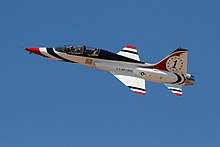
.jpg)
- German Air Force - 46 T-38A in 1968, now upgraded to T-38C. All aircraft are stationed at Sheppard AFB, Texas and are painted in US markings.[30]
- Portuguese Air Force - 12 aircraft in 1977. Initially operated by 201 Sqn. "Falcões" (Falcons) at Air Base No. 5, in 1980 they were transferred to 103 Sqn. "Caracóis" (Snails) being stationed in Air Base No. 11. They were retired in 1993 replaced by Dassault/Dornier Alpha Jet[31]
- Republic of Korea Air Force - thirty T-38A from the US in April 1999. All units were returned to the US by 2009 after near completion of production of T-50 Golden Eagle supersonic trainer.[32]
- Republic of China Air Force - former operator, all aircraft returned to the US in 1998.[33]
- Turkish Air Force - 33 T-38M in service.[34]
- United States Air Force - 500 T-38 trainers in service as of September 2018.[35]
- 1st Fighter Wing – Langley AFB, Virginia
- 2d Fighter Training Squadron
- 435th Flying Training Squadron
- 49th Flying Training Squadron
- 88th Flying Training Squadron
- 2d Fighter Training Squadron
- 43d Flying Training Squadron (Columbus AFB)
- 96th Flying Training Squadron (Laughlin AFB)
- 97th Flying Training Squadron (Sheppard AFB)
United States Navy - 10 aircraft in use as November 2008.[37]
NASA - approximately 32 aircraft bailed from USAF
Aircraft on display
.jpg)

.jpg)
- T-38A
- 58-1196 – California Science Center, in Los Angeles, California[38]
- 59-1601 – On base display, Air University area, Maxwell AFB, Alabama[39]
- 59-1602 – On base display, United States Air Force Academy, in Colorado Springs, Colorado. Painted as "Thunderbird 1"
- 59-1604 – National Naval Aviation Museum, NAS Pensacola, Florida; former USAF aircraft bailed to USN and utilized by the U.S. Naval Test Pilot School at NAS Patuxent River, Maryland.[40]
- 59-1605 – On base display, USAF History and Traditions Museum, Lackland AFB, Texas[41]
- 60-0549 – Prairie Aviation Museum, in Bloomington, Illinois[42]
- 60-0551 – To be displayed at the National Air and Space Museum in Washington, DC[43]
- 60-0558 – American Legion Post 233 in Edinburgh, Indiana[44]
- 60-0570 – Edward F. Beale Museum, Beale AFB, California[45]
- 60-0573 - On display, Owatonna Degner Regional Airport, Owatonna, Minnesota (with 60-0589 and 61-0828)
- 60-0574 – On base display, Laughlin AFB, Texas[46]
- 60-0589 - On display, Owatonna Degner Regional Airport, Owatonna, Minnesota (with 60-0573 and 61-0828)
- 61-0817 – Oklahoma Welcome Station, adjacent to Tinker AFB, Oklahoma.[47]
- 61-0828 - On display, Owatonna Degner Regional Airport, Owatonna, Minnesota (with 60-0573 and 60-0589)
- 61-0829 - Gallup Municipal Airport, Gallup, New Mexico [48]
- 61-0838 – On base display, in front of Randolph Inn Visiting Officers Quarters (VOQ), Randolph AFB, Texas[49]
- 61-0854 – Pima Air and Space Museum, adjacent to Davis-Monthan AFB in Tucson, Arizona, on display in the markings of the 479th Tactical Training Wing at Holloman AFB, NM, circa 1982.[50]
- 61-0858 – Sheppard AFB Air Park, Sheppard AFB, Texas[51]
- 61-0902 – Science Spectrum in Lubbock, Texas.[52]
- 61-0926 - Salina Oklahoma, lawn of American Legion post #240 [53]
- 62-3673 - Mason County Airport (Michigan) Construction Number (C/N)- N.5378, built 1962, painted blue and gray camouflage static displayed on a pedestal along US10 showing USAF tail markings of the 434th Fighter Training Squadron when it was located at Holloman Air Force Base between 1977 and 1991
- 63-8125 – Sheppard AFB Air Park, Sheppard AFB, Texas[51]
- 63-8224 – Evergreen Aviation & Space Museum in McMinnville, Oregon; painted in NASA colors, suspended from the ceiling in the Air and Space Exhibit Hall.[54]
- 65-10405 – On base display, Columbus AFB, Mississippi[55][56]
- 65-10426 – On base display, Vance AFB, Oklahoma[57]
- 66-8381 / NASA 901 (N901NA) – Assigned directly to NASA as the second NASA T-38 to be designated as 'NASA 901' and 'N901NA'; on display at Aviation Heritage Park, Bowling Green, Kentucky[58][59]
- GT-38A
- 60-0592 – Dyess Linear Air Park, Dyess AFB, Texas[60]
- 60-0593 – March Field Air Museum at March ARB (former March AFB) in Riverside, California, on display in Thunderbirds markings.[61]
- 61-0824 – Hill Aerospace Museum adjacent to Hill AFB, Utah.[62]
- YT-38A
- 58-1192 – South Dakota Air and Space Museum at Ellsworth AFB, South Dakota.[63]
- AT-38B
- 60-0576 – On base display, Holloman AFB, New Mexico.[64]
- 65-10441 – National Museum of the United States Air Force at Wright-Patterson AFB in Dayton, Ohio. This aircraft was retired in 1991, came to the museum in 1999, and was placed on display in 2004.[65]
- T-38N
- 65-10329 / NASA 969 (N969NA) – On display at Kennedy Space Center Visitor Complex, NASA/John F. Kennedy Space Center, Merritt Island, Florida[66]
- 65-10355 / NASA 913 (N913NA) – On display at the Intrepid Sea, Air & Space Museum, New York, New York[67]
- 66-8381 / NASA 901 (N901NA) – Assigned directly to NASA as the second NASA T-38 to be designated as NASA 901 and N901NA; on display at Aviation Heritage Park, Bowling Green, Kentucky
Specifications (T-38A)
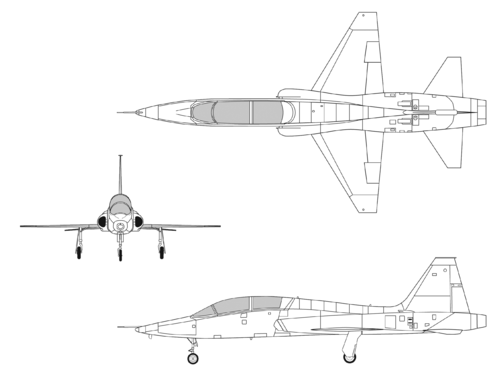
Data from USAF factsheet[5]
General characteristics
- Crew: 2
- Length: 46 ft 4.5 in (14.135 m)
- Wingspan: 25 ft 3 in (7.70 m)
- Height: 12 ft 10.5 in (3.924 m)
- Wing area: 170 sq ft (16 m2)
- Empty weight: 7,200 lb (3,266 kg)
- Gross weight: 11,820 lb (5,361 kg)
- Max takeoff weight: 12,093 lb (5,485 kg)
- Powerplant: 2 × General Electric J85-5A afterburning turbojet engines, 2,050 lbf (9.1 kN) thrust each dry, 2,900 lbf (12,899.84 N) with afterburner
- (J85-5R after PMP modification)[68]
Performance
- Maximum speed: 746 kn (858 mph, 1,382 km/h)
- Maximum speed: Mach 1.3
- Range: 991 nmi (1,140 mi, 1,835 km)
- Service ceiling: 50,000 ft (15,000 m)
- Rate of climb: 33,600 ft/min (171 m/s) [69]
- Wing loading: 69.53 lb/sq ft (339.5 kg/m2)
- Thrust/weight: 0.65
See also
Related development
Related lists
References
Notes
- Johnsen 2006, pp. 5–6
- Eden 2004, p. 344
- Due to its elongated fuselage - the pilot's operating handbook for the two-seat version contains an instruction to avoid spins.
- "Northrop marks 50th anniversary of T-38 Talon first flight." Archived 2012-04-06 at the Wayback Machine defencetalk.com, 14 April 2009. Retrieved: 21 August 2011.
- "T-38 TALON Fact Sheet". U.S. Air Force. 2 May 2008. Archived from the original on 2 June 2013.
- TO 1T-38A-4, USAF T-38 Tech Order
- "USAF Almanac 2018" (PDF). Archived (PDF) from the original on 2019-05-07. Retrieved 2018-11-28.
- "New Fighter Jet Unveiled By Iranian Military". Forces Network. British Forces Broadcasting Service. 21 August 2018. Retrieved 29 September 2019.
- "Iran unveils new domestically-produced fighter jet". BBC. 21 August 2018. Retrieved 29 September 2018.
- "Eyeing U.S., Iran unveils new fighter jet". Reuters. August 22, 2018. Retrieved September 29, 2019.
- Butler, Amy (6 April 2015). "T-X Competition Fierce Despite GD, Alenia Split". Aviation Week & Space Technology. Archived from the original on 7 April 2015. Retrieved 7 April 2015.
- "USAF Braces For Fiscal Bombardment." AW & ST, 20 September 2010
- Power play, The World column, AW & ST, 16 September 2013, p. 12
- Reim, Garrett (September 27, 2018). "Boeing wins $9.2b T-X trainer contract with USAF". FlightGlobal.com. Los Angeles: Flight International. Archived from the original on September 28, 2018. Retrieved September 28, 2018.
- "Aircraft – Make / Model Results: Northrop T-38." Archived 2012-01-12 at the Wayback Machine FAA Registry. Retrieved 21 August 2011
- Creech, Gray. "T-38 Supersonic Trainer Jet Gets New Home." Archived 2011-08-02 at the Wayback Machine NASA. Retrieved 21 August 2011
- "Discovery's final crew arrives at NASA's Kennedy Space Center". Archived from the original on 2017-03-12. Retrieved 2017-03-09.
- "Northrop T-38 Losses and Ejections". Archived from the original on November 12, 2014. Retrieved September 29, 2019.
- "Crash Kills Astronaut." Richland, WA – Tri City Herald, 1 November 1964
- "Goose Hit Jet, Killing Astronaut." The Miami News, 17 November 1964
- "2 Astronauts Die In Plane Crash." The Tuscaloosa News, 28 February 1966
- "See – Bassett Backup Crew Gets Gemini." Daytona Beach, FL – Morning Journal newspaper, 1 March 1966
- "Williams Wanted To Be First On The Moon." St. Petersburg, FL -Evening Independent newspaper, 6 October 1967
- "Board Pinpoints Astronaut's Death." Sarasota, FL – Herald-Tribune newspaper, 7 June 1968
- Andrade 1979, p. 167
- "Modifications & Modernization T-38 Avionics Modernization Program." Archived 2011-08-15 at the Wayback Machine Turkish International Cooperation and Export Activities. Retrieved 21 August 2011
- "NASA T-38N Hangar, Ellington Field". airliners.net. Archived from the original on December 19, 2014.
- "Northrop Space Trainer". The Aeroplane, 3 April 1959, p. 393
- "Thursday, November 12, 1959". ad.nl/utrecht/. Utrechts Nieuwsblad. November 12, 1959. Archived from the original on November 12, 1959.
- "Luftwaffe History". Geschichte der Luftwaffe. Retrieved September 26, 2019.
- Sanzani, Matteo (January 17, 2018). "Portugal Retires Alpha Jet". blogbeforeflight.net. Archived from the original on July 10, 2018. Retrieved September 26, 2019.
- "T-38s Reborn". Air Forces Monthly. Key Publishing Limited. January 19, 2011. Archived from the original on 2018-08-30. Retrieved 2018-08-30.
- "Taiwan Air Power". TaiwanAirPower.org. April 13, 2008. Archived from the original on November 21, 2009. Retrieved August 30, 2018.
- "Aircraft Inventory". Turkish Air Force Command. Archived from the original on May 12, 2016. Retrieved June 12, 2016.
- http://www.airforcemag.com/MagazineArchive/Magazine%20Documents/2019/June%202019/0619_Equipment.pdf
- 509th Bomb Wing Public Affairs Staff. "Whiteman's esteemed B-2 Spirit pilots merged into single squadron". Archived from the original on 2019-01-03. Retrieved 2019-01-03.
- "Directory: World Air Forces." Archived 2017-10-11 at the Wayback Machine Flight International, 11–17 November 2008
- "Northrop T-38 Talon". California Science Center. Archived from the original on June 23, 2015.
- "Maxwell AFB Display Aircraft". Warbird Information Exchange. Archived from the original on 2014-09-14. Retrieved September 26, 2019.
- "USNTPS T-38 at Wikipedia Commons". Naval Aviation Museum, Pensacola, Florida. Archived from the original on March 2, 2015.
- "Lackland Air Force Base USAF History and Traditions Museum". aero-web. Aviation Enthusiast Corner. Archived from the original on August 31, 1999.
- "T-38 Talon/60-0549." Archived 2013-10-16 at the Wayback Machine Prairie Aviation Museum. Retrieved 12 April 2013
- "Going Subsonic: Moving the T-38 Talon". National Air and Space Museum. 2019-03-27. Retrieved 2020-03-11.
- "GT-38A Talon 60-0558 in Edinburgh." Archived 2014-12-19 at the Wayback Machine Talon in Edinburgh
- "Edward F. Beale Museum". aero-web. Aviation Enthusiast Corner. Archived from the original on November 21, 2014.
- "Laughlin AFB". aero-web. Archived from the original on September 17, 2014. Retrieved September 14, 2014.
- "T-38 Talon/61-0817." Archived 2012-10-03 at the Wayback Machine Warbird Registry. Retrieved 12 April 2013
- Google Maps 35.5155497,-108.7794413,276
- "Randolph AFB Aircraft Display". Warbird Information Exchange. Archived from the original on September 14, 2014.
- "T-38 Talon/61-0854". Pima Air & Space Museum. Archived from the original on 2013-10-30. Retrieved April 12, 2013.
- "Sheppard AFB Air Park". Archived from the original on September 17, 2014. Retrieved September 14, 2014.
- "T-38 Talon/61-0902." Archived 2012-09-30 at the Wayback Machine Warbird Registry. Retrieved 12 April 2013
- "Salina, Oklahoma, Local Attractions". Retrieved October 1, 2019.
- "T-38 Talon/63-8224." Archived 2013-05-01 at the Wayback Machine Evergreen Aviation & Space Museum. Retrieved 12 April 2013
- "Northrop T-38A Talon - USA - Air Force". airliners.net. Archived from the original on September 14, 2014.
- "Northrop T-38A Talon SN: 65-10405". aero-web. Archived from the original on March 4, 2016. Retrieved September 13, 2014.
- "Northrop T-38A Talon SN: 65-10426". aero-web. Archived from the original on October 11, 2011. Retrieved September 14, 2014.
- "NASA T-38 Talon". Aviation Heritage Park. Archived from the original on October 29, 2014.
- Wilson, Laurel (March 23, 2014). "NASA T-38 Talon plane arrives in BG". Bowling Green Daily News. Retrieved October 1, 2019.
- "Dyess Linear Air Park". aero-web. Archived from the original on March 31, 1999.
- "T-38 Talon/60-0593." Archived 2012-01-08 at the Wayback Machine March Field Air Museum. Retrieved 12 April 2013
- "T-38 Talon/61-0824." Archived 2013-04-23 at the Wayback Machine Hill Aerospace Museum. Retrieved 12 April 2013
- "T-38 Talon/58-1192." Archived 2017-08-06 at the Wayback Machine South Dakota Air and Space Museum. Retrieved 12 April 2013
- "T-38 Talon/60-0576." Archived 2012-09-26 at the Wayback Machine Warbird Registry. Retrieved 12 April 2013
- "T-38 Talon/65-10441." Archived 2013-04-04 at the Wayback Machine National Museum of the USAF. Retrieved 12 April 2013
- "NASA Space Center Museum". tinfeathers.com. Archived from the original on April 12, 2013.
- "Northrop T-38N Talon Hoisted to Flight Deck" Archived 2018-06-12 at the Wayback Machine Intrepid Museum. Retrieved 11 July 2018.
- "T-38s modified by the propulsion modernization program have approximately 19 percent more thrust, reducing takeoff distance by 9 percent." (T-38 Talon USAF Fact Sheet)
- Even though this value has been printed in USAF outlets for many years, it is probably incorrect. The T-38 time-to-climb record, set in 1962, was 3 minutes to 30,000 feet. According to Northrop's Roy Martin (quoted on p. 64 of Air & Space/Smithsonian, Vol. 20, No. 3 (August/September 2005)), a normal climb at military power - that is, maximum power without afterburner - is around 6,000 feet/minute.
Bibliography
- Andrade, John U.S. Military Aircraft Designations and Serials since 1909 Midland Counties Publications, 1979, ISBN 0 904597 22 9
- Eden, Paul, ed. "Northrop F-5 family". Encyclopedia of Modern Military Aircraft. London: Amber Books, 2004. ISBN 1-904687-84-9
- Johnsen, Frederick A. Northrop F-5/F-20/T-38. North Branch, Minnesota: Specialty Press, 2006. ISBN 1-58007-094-9
- Shaw, Robbie. F-5: Warplane for the World. St. Paul, Minnesota: Motorbooks International, 1990. ISBN 0-87938-487-5
External links
| Wikimedia Commons has media related to Northrop T-38 Talon. |
- T-38 Talon page on GlobalSecurity.org
- T-38 Talon page on SR-71.org
- NASA photo gallery
- "White Rocket," Air & Space/Smithsonian Magazine, Vol. 20, No. 3 (August/September 2005), pp. 58–65